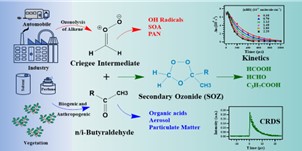The reactions of the simplest Criegee intermediate (CH2OO) with n-butyraldehyde (nBD) and isobutyraldehyde (iBD) were studied at 253–318 K and (50 ± 2) torr, using Cavity Ring-down spectroscopy (CRDS). The rate coefficients obtained at room temperature were (2.63 ± 0.14) × 10−12 and (2.20 ± 0.21) × 10−12 cm3 molecule−1 s−1 for nBD and iBD, respectively. Both the reactions show negative temperature-dependency, following equations, knBD(T = 253–318 K) = (11.51 ± 4.33) × 10−14 × exp{(918.1 ± 107.2)/T} and kiBD(T = 253–318 K) = (6.23 ± 2.29) × 10−14 × exp{(1051.4 ± 105.2)/T} cm3 molecule−1 s−1. High-pressure limit rate coefficients were determined from theoretical calculations at the CCSD(T)-F12/cc-pVTZ-F12//B3LYP/6-311+G(2df, 2p) level of theory, with <40% deviation from the experimental results at room temperature and above. The kinetic simulations were performed using a master equation solver to predict the temperature-dependency of the rate coefficients at the experimental pressure, as well as to predict the contribution of individual pathways. The major products predicted from the theoretical calculations were formaldehyde and formic acid, along with butyric acid from nBD and isobutyric acid from iBD reactions.
-
Call
-
E-mail
Journal Details
1. Experimental and theoretical study of Criegee intermediate (CH2OO) reactions with n-butyraldehyde and isobutyraldehyde: kinetics, implications and atmospheric fate.
A. Debnath and B. Rajakumar Phys. Chem. Chem. Phys, 2024, 6872-6884, 26

